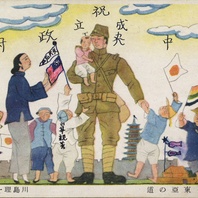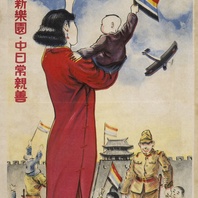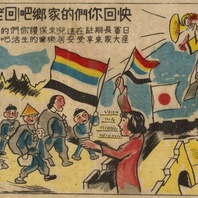
Item
Kagayaku Tōa no michi (The road to a shining East Asia)
This postcard, featuring an illustration by the prolific Japanese artist Riichiro Kawashima, shows a Japanese soldier celebrating “kagayaku Tōa no michi” (the road to a shining East Asia), with Chinese civilians. Of interest here is the fact that the Republican Chinese flag appears to have been drawn onto the postcard (and made to look as if it is being held by the child dressed in white), while other figures in the image hold the “five-coloured flag (wuseqi). The “five-coloured flag” was used by the Reformed Government of the Republic of China (RGROC) up until March 1940, but was replaced by the Republican Chinese flag with the formation of Wang Jingwei’s government. This suggests that the postcard was made prior to March 1940, but used some time thereafter. Text reading “qing zhu xin zhongyang zhengfu chengli” (Celebrating the founding of the new central government) has also been added above the figures, while the phrase “Ri-Hua qinshan” (Japanese-Chinese friendship) has been added to the boy in white.
Read More

Item
Ertong xin leyuan, Zhong-Ri chang qinshan (New paradise for children; China and Japan will forever be close)
This poster, almost certainly produced with the aim of encouraging civilians in occupied Beijing to embrace Japanese rule, includes many of the standard tropes of early occupied north China propaganda: a “new woman” with a male child; city walls; Japanese soldiers fraternising with Chinese infants; the “five-coloured flag” (wuseqi); and a sky filled with Japanese airplanes.
Read More

Item
Kuai hui nimen de jiaxiang ba! (Hurry back to your homes!)
This leaflet, produced with the aim of encouraging civilians in occupied north China to return to cities and towns under Japanese rule, includes many of the standard tropes of early occupied north China propaganda: a “new woman”; city walls; the “five-coloured flag” (wuseqi). The text on the leaflet reads: “Hurry back to your homes! Return to your hometowns! The Japanese army will be here for a long time. Come and protect your livelihoods and your assets. Everyone can savour living in peace and enjoying their work again”.